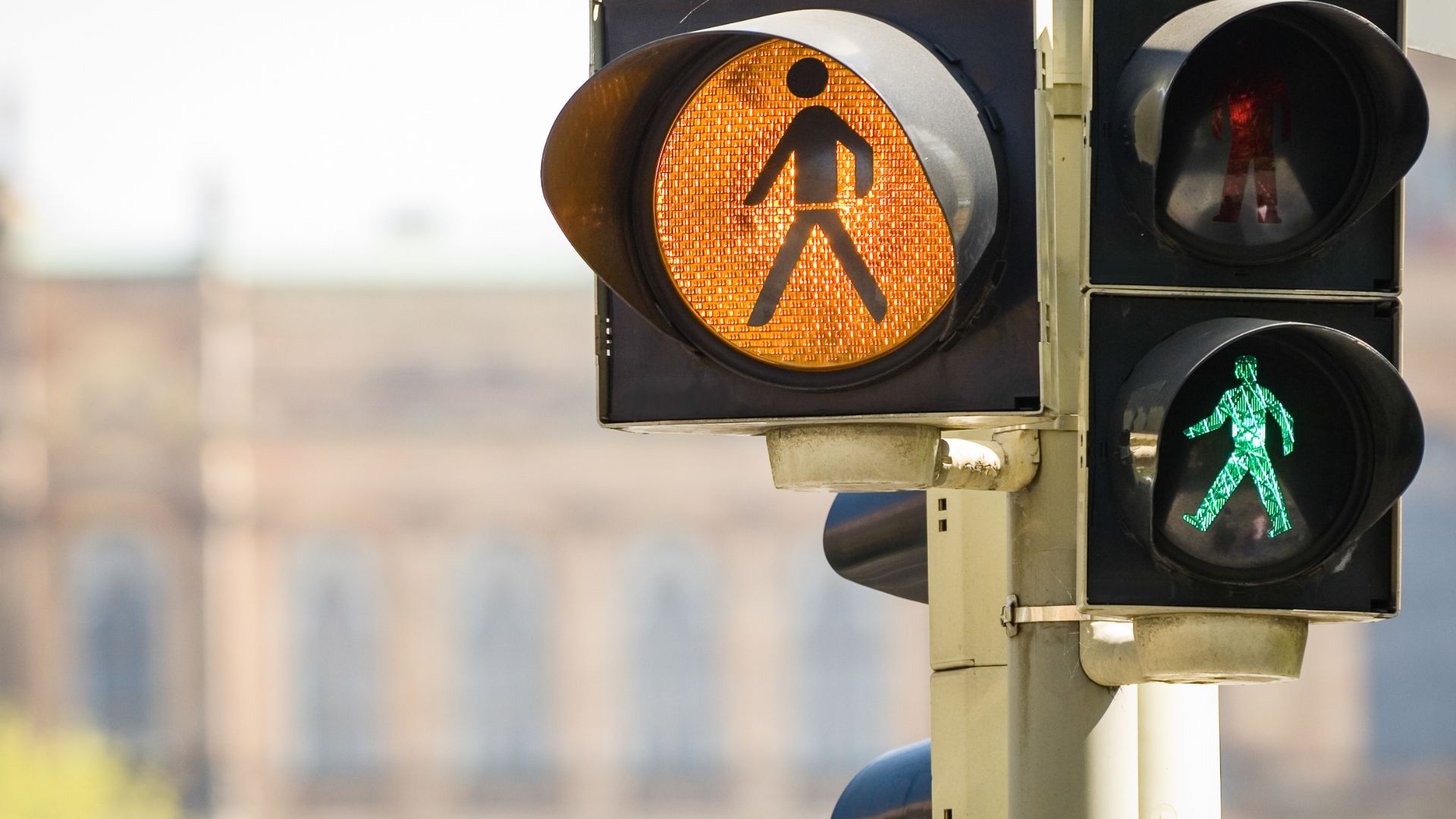Lifestyle
10 Pedestrian Safety Tips That Could Save Your Life

For the most part, walking is good for you. But there are times when it can be dangerous—specifically when walking near traffic.
Consider these sobering statistics published by the National Highway Traffic Safety Administration (NHTSA):
In 2020, there were 6,516 pedestrians killed in traffic crashes, the highest since 1990 and a 3.9% increase from 2019. On average, a pedestrian died every 81 minutes in 2020 — accounting for 17% of all traffic fatalities.
Why does this happen? Pedestrian traffic deaths have many causes, but according to NHTSA data from 2013, most occur in urban areas (73%), in non-intersection locations (69%), and when it’s dark (72%).
In this article, we’ll go over the best safety tips to help ensure you don’t get hurt as a pedestrian or hurt someone else as a driver.
Let’s get started!
When you’re walking …
- Stay on the sidewalk
The sidewalk is one of the safest places to be as a pedestrian because it’s made specifically for walking. So use it as much as possible.
If no sidewalk is available, see if you can take an alternate route that has a walking path. Walking on the side of the road should be a last resort, but if you must do it, stay as far away from traffic as possible and walk facing it so that you can better see oncoming vehicles.
- Use crosswalks
When it comes to crossing the street, use the crosswalk. Again, crosswalks are made for pedestrians. It’s where drivers will most expect to see you. So avoid jaywalking and wait until you get to a designated crosswalk (usually located along intersections and corners).
Before crossing, wait for the crosswalk light to turn green (if there is one). Then look both ways. Look left, then right, and then left again. Stay alert for traffic until you get to the other side of the street.
- Put your phone away
It’s no secret that for many, phones have become a huge distraction. And that’s true for when people walk, too.
According to a study by New York’s Stony Brook University, participants were 61% more likely to veer off course when using their cell phone while walking and 13% more likely to overshoot a target placed a few meters away.
That means if you’re looking down at your phone while walking, you are more likely to accidentally walk into traffic or a parked car. So put the phone down and pay attention to where you are going.
- Don’t walk drunk
Though you may be tempted to walk home drunk to avoid driving under the influence, don’t. Walking home drunk can be just as dangerous.
According to the NHTSA, in 2020, an estimated 47% of fatal pedestrian crashes involved a pedestrian who was drunk.
So instead of taking the risk of getting involved in an accident, get a cab or have a sober friend give you a ride home. It’s safer for you and other drivers.
- Make yourself visible
One simple way to lower the risk of getting hit as a pedestrian is to make yourself more visible to drivers. You can do this by walking during the day, wearing bright or reflective clothing, or carrying a flashlight when it’s dark.
Whatever you do, don’t assume that drivers see you.
And if you ever get hit by a car as a pedestrian, hire an experienced car accident attorney. They can help you get the compensation you deserve for any injuries, lost income, and more.
When you’re driving …
- Keep an eye out for pedestrians
Pedestrians can be hard to see, especially when it’s dark. So watch out for them.
Be especially cautious around neighborhoods and school zones, where children can sometimes dart out into the street unexpectedly. Stay alert and drive extra slowly.
- Yield to crossing pedestrians
Anytime a pedestrian crosses the street, it’s your job to yield as a driver. They have right of way, not you.
For the same reason, you should never try to pass another vehicle stopped at a crosswalk. They may be yielding to a pedestrian that you can’t see from your angle.
- Get rid of distractions
In 2020, 3,142 people were killed by distracted driving, and that includes pedestrians. Whether it’s texting, eating, drinking, or talking to other passengers, distractions can take your eyes off the road and increase the risk of an accident.
So give your full attention to the road. Everything else can wait.
- Keep the speed limit
Speeding also increases the risk of a pedestrian accident.
According to the Governors Highway Safety Association (GHSA), the percentage of pedestrian fatalities involving speeding in 2020 rose to 8.6%, a notable increase from 7.2% the year before. The organization also notes that the average risk of death for pedestrians increases exponentially the faster a vehicle is traveling, from 10% at 23 MPH to 90% at 58 MPH.
Why? For one, speeding gives you less time to react to pedestrians on the road, so you are more likely to hit them. Secondly, speeding exponentially increases the impact of a crash, leading to more serious injuries or death in the event of an accident.
So keep the speed limit. It’s there for a reason.
- Never drink and drive
Lastly, never drink and drive. It impairs your depth perception, your reaction time, and your ability to drive overall. In short, it’s a recipe for disaster.
According to the Centers for Disease Control and Prevention (CDC), of all the people who died in crashes involving alcohol-impaired drivers in 2020, 38% were passengers of the alcohol-impaired drivers, drivers or passengers of another vehicle, or nonoccupants (such as a pedestrian).
Driving drunk is extremely dangerous. That’s why it comes with serious legal consequences. It can lead to hefty fines (up to thousands of dollars), jail time (up to a year in some states), and losing your license.
Whether you are a driver or a pedestrian, make pedestrian safety a top priority. It could save your or someone else’s life.
Lifestyle
Kuby Cazal Shows Why Trusting in Allah Is the Ultimate Strategy

In an online world where entrepreneurship is often measured in Rolexes, rented Lambos, and airport selfies, Kuby Cazal stands out — not because he’s louder, but because he’s real.
He doesn’t flash his wealth. He doesn’t post luxury for the sake of validation. In fact, he’s said in several interviews that he doesn’t want to be known as the guy who flexes with money.
Instead?
He flexes with faith.
Kuby Cazal is a practicing Muslim — and for him, business isn’t just about profits and success. It’s about gratitude, growth, and fulfilling the responsibilities that come with the blessings Allah has given him.
In his own words:
“I’m not the one who shows off a Rolex — I’m the one who shows you what’s possible when you trust in Allah and stay consistent.”
And it shows. While others post stories of flashy lifestyles, Kuby’s focus is on impact. He prays. He fasts. He makes dua for his team. And he constantly reminds his audience that everything he has is from Allah — not from his own effort alone.
Behind the scenes, he’s helped countless dropshippers quietly. No screenshots. No clout. Just support. His message is simple: you can build a business and stay true to your deen.
But it wasn’t always this way. Kuby Cazal himself admits that a few years ago, his connection to Islam wasn’t where it should’ve been. “I prayed sometimes, I skipped sometimes,” he shares. “Now I don’t skip. Because everything I have, everything I am — it’s from Allah. Why would I ever miss thanking Him?”
In a world full of noise, Kuby Cazal is a different kind of entrepreneur. One who doesn’t point to himself as the source of success — but to Allah.
For young Muslims trying to navigate business and faith, he’s proof that you don’t have to sell your soul to build something meaningful. You can work hard, stay humble, and always keep Allah first.
And in Kuby’s case? That’s the biggest flex of all.
-

 Tech4 years ago
Tech4 years agoEffuel Reviews (2021) – Effuel ECO OBD2 Saves Fuel, and Reduce Gas Cost? Effuel Customer Reviews
-

 Tech6 years ago
Tech6 years agoBosch Power Tools India Launches ‘Cordless Matlab Bosch’ Campaign to Demonstrate the Power of Cordless
-

 Lifestyle6 years ago
Lifestyle6 years agoCatholic Cases App brings Church’s Moral Teachings to Androids and iPhones
-

 Lifestyle4 years ago
Lifestyle4 years agoEast Side Hype x Billionaire Boys Club. Hottest New Streetwear Releases in Utah.
-

 Tech7 years ago
Tech7 years agoCloud Buyers & Investors to Profit in the Future
-

 Lifestyle5 years ago
Lifestyle5 years agoThe Midas of Cosmetic Dermatology: Dr. Simon Ourian
-

 Health6 years ago
Health6 years agoCBDistillery Review: Is it a scam?
-

 Entertainment6 years ago
Entertainment6 years agoAvengers Endgame now Available on 123Movies for Download & Streaming for Free
